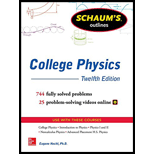
Concept explainers
Steel and silver wires of the same diameter and same length are stretched with equal tension. Their densities are
The fundamental frequency of the silver wire when the fundamental frequency of the steel wire of similar dimensions is
Answer to Problem 38SP
Solution:
Explanation of Solution
Given data:
The fundamental frequency of the steel wire is
Density of silver wire is
Density of the steel wire is
Formula used:
The relationship between mass and density is
Here,
The formula of fundamental frequency is
Here,
Explanation:
Recall the relationship between mass and volume:
Calculate the mass of the steel wire.
Substitute
Calculate the mass of the silver wire.
Substitute
Recall the formula of fundamental frequencyAnd write the expression for fundamental frequency of the steel wire:
Here,
Substitute
Similarly, write the fundamental frequency of the silver wire:
Here,
Substitute
Find the ratio of
Substitute
Conclusion:
The fundamental frequency of thesilver wire is
Want to see more full solutions like this?
Chapter 22 Solutions
Schaum's Outline of College Physics, Twelfth Edition (Schaum's Outlines)
- A wave travels upward in a medium (vertical wave velocity). What is the direction of particle oscillation for the following? (a) a longitudinal wave parallel to the direction of propagationperpendicular to the direction of propagationarrow_forwardThe faster a molecule is moving in the upper atmosphere, the more likely it is to escape Earth's gravity. Given this fact, and your knowledge of rms speed, which of the following molecules can escape most easily from Earth's atmosphere if they are all at the same temperature?arrow_forwardThe temperature in one part of a flame is 2,100 K. What is the rms velocity of the carbon dioxide molecules at this temperature? Give your answer as the number of meters per second. mass of 1 mole of CO2 = 44.0 grams 1 mole contains 6.02 x 1023 molecules the Boltzmann constant k = 1.38 x 10-23 J/Karrow_forward
- The specific heat of a certain substance is 375 J/(kg°C). How much heat energy would you have to add to increase the temperature of 22 kg of this substance from 33°C up to 44°C in a number of Joules?arrow_forward3.9 moles of an ideal gas are sealed in a container with volume 0.22 m3, at a pressure of 146,000 N/m2. What is the temperature of the gas in degrees Celsius?arrow_forwardwhen a cannon is launched at a 65 degree angle, will it have the same horizontal velocity as when it is launched from a 25 degree angle as long as the initial speed is the same?arrow_forward
- Please solve the problem step by step with explanations along each step explaining what's been done.Thank you!!arrow_forwardFigure 8.14 shows a cube at rest and a small object heading toward it. (a) Describe the directions (angle 1) at which the small object can emerge after colliding elastically with the cube. How does 1 depend on b, the so-called impact parameter? Ignore any effects that might be due to rotation after the collision, and assume that the cube is much more massive than the small object. (b) Answer the same questions if the small object instead collides with a massive sphere.arrow_forward2. A projectile is shot from a launcher at an angle 0,, with an initial velocity magnitude vo, from a point even with a tabletop. The projectile hits an apple atop a child's noggin (see Figure 1). The apple is a height y above the tabletop, and a horizontal distance x from the launcher. Set this up as a formal problem, and solve for x. That is, determine an expression for x in terms of only v₁, 0, y and g. Actually, this is quite a long expression. So, if you want, you can determine an expression for x in terms of v., 0., and time t, and determine another expression for timet (in terms of v., 0.,y and g) that you will solve and then substitute the value of t into the expression for x. Your final equation(s) will be called Equation 3 (and Equation 4).arrow_forward
 Physics for Scientists and Engineers: Foundations...PhysicsISBN:9781133939146Author:Katz, Debora M.Publisher:Cengage Learning
Physics for Scientists and Engineers: Foundations...PhysicsISBN:9781133939146Author:Katz, Debora M.Publisher:Cengage Learning Principles of Physics: A Calculus-Based TextPhysicsISBN:9781133104261Author:Raymond A. Serway, John W. JewettPublisher:Cengage Learning
Principles of Physics: A Calculus-Based TextPhysicsISBN:9781133104261Author:Raymond A. Serway, John W. JewettPublisher:Cengage Learning Physics for Scientists and Engineers, Technology ...PhysicsISBN:9781305116399Author:Raymond A. Serway, John W. JewettPublisher:Cengage Learning
Physics for Scientists and Engineers, Technology ...PhysicsISBN:9781305116399Author:Raymond A. Serway, John W. JewettPublisher:Cengage Learning Glencoe Physics: Principles and Problems, Student...PhysicsISBN:9780078807213Author:Paul W. ZitzewitzPublisher:Glencoe/McGraw-Hill
Glencoe Physics: Principles and Problems, Student...PhysicsISBN:9780078807213Author:Paul W. ZitzewitzPublisher:Glencoe/McGraw-Hill University Physics Volume 1PhysicsISBN:9781938168277Author:William Moebs, Samuel J. Ling, Jeff SannyPublisher:OpenStax - Rice University
University Physics Volume 1PhysicsISBN:9781938168277Author:William Moebs, Samuel J. Ling, Jeff SannyPublisher:OpenStax - Rice University Physics for Scientists and EngineersPhysicsISBN:9781337553278Author:Raymond A. Serway, John W. JewettPublisher:Cengage Learning
Physics for Scientists and EngineersPhysicsISBN:9781337553278Author:Raymond A. Serway, John W. JewettPublisher:Cengage Learning





